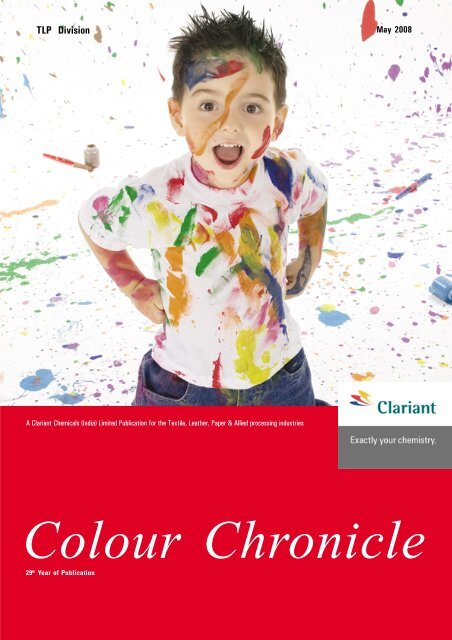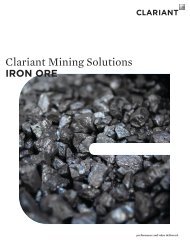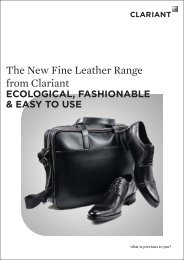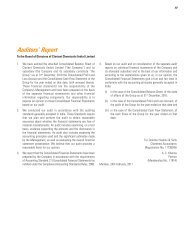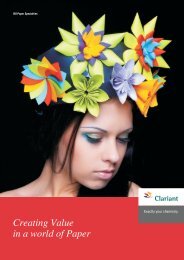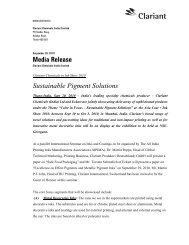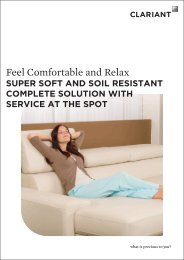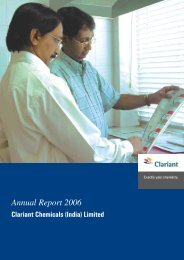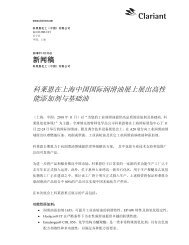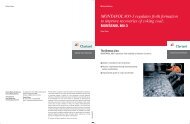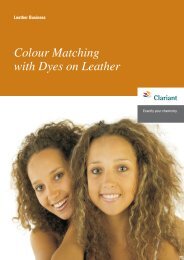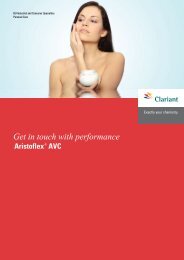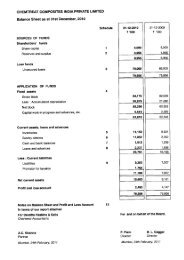Colour Chronicle - Clariant
Colour Chronicle - Clariant
Colour Chronicle - Clariant
You also want an ePaper? Increase the reach of your titles
YUMPU automatically turns print PDFs into web optimized ePapers that Google loves.
TLP Division<br />
A <strong>Clariant</strong> Chemicals (India) Limited Publication for the Textile, Leather, Paper & Allied processing industries<br />
<strong>Colour</strong> <strong>Chronicle</strong><br />
May May 2008 2008<br />
<strong>Colour</strong> <strong>Chronicle</strong><br />
29th Year of Publication<br />
1
Pantone Partnership....................6<br />
New Innovations ......................10<br />
Pilot Coater..................................14<br />
2<br />
<strong>Colour</strong> <strong>Chronicle</strong><br />
May 2008<br />
Textile<br />
<strong>Clariant</strong> - Pantone Partnership............................................6<br />
Leather<br />
New Innovations ...........................................................10<br />
Paper<br />
Pilot Coater.................................................................14<br />
GOTS Approved List ....................................................18<br />
New Arrivals.............................................................. 19<br />
PRIMA Training ...........................................................22<br />
Inside Views ...........................................................23<br />
Awards ...........................................................25<br />
Gleanings from Press ................................................... 26
Views on Current Scenario in Textiles<br />
What are the issues that will drive future<br />
trade?<br />
The future trade will be driven by<br />
innovation, creative imitation , timely<br />
delivery, after sales service are the key<br />
factors which will drive future business<br />
and hence supply chain management will<br />
be the key for the growth to come in the<br />
business.<br />
Unlike earlier, today's market is buyer driven<br />
and the final consumer is calling the shots....<br />
In textiles especially consumer textiles,<br />
always it was buyers who called the shot<br />
because textile is one of the oldest<br />
industry in India and competition has<br />
always been there. Today, due to rising<br />
exports it is not the consumers who are<br />
calling the shots but the middleman may<br />
be in the form of buying agents retail<br />
stores, big shopping malls are calling the<br />
shots. Here again the prices of real<br />
consumers is very high. Instead of calling<br />
consumer advantage it can be nominated<br />
as customer advantage. There should<br />
not be any doubt – customers and<br />
consumers are two different people and<br />
hence it is the customers' shots the<br />
industry is facing.<br />
How do you assess threat from China?<br />
We cannot ignore the fact that China is a<br />
bigger player in almost all the segments<br />
of textiles and they will continue to give<br />
run for the money because China has<br />
achieved economies of scale, their costs<br />
are aligned to market forces and hence<br />
high quality low cost products from India<br />
can only compete with China. In the local<br />
markets also Chinese goods are<br />
occupying the shelf space of the retail<br />
stores. Hence Indian industries must<br />
immediately work towards consolidation<br />
bringing in the economies of scale and<br />
cost advantages to the customers.<br />
In future the brands are going to play a major<br />
role and they will be the decision maker, so<br />
how do you see this branding issue?<br />
We have seen in South East Asian<br />
markets that the emergence of super<br />
stores will give a major role of brands<br />
especially international brands. An<br />
Indian textile industry will have to<br />
remodel their manufacturing facilities to<br />
provide quick deliveries in a short lead<br />
time and also must adjust itself to small<br />
runs. Other than this, most of the Indian<br />
garment industries will be working as<br />
back end office for the brands in terms of<br />
providing timely logistical support etc.<br />
Brands have arrived to stay long and<br />
hence no industry can ignore this fact.<br />
But ultimate consumer may not get the<br />
benefit of low cost as the brands have to<br />
spend huge money in maintaining the<br />
State of the Art shelves.<br />
How do you see the role of dyes and chemical<br />
companies in future to help textile industry?<br />
The textile industry will need close cooperation<br />
with the dyes and chemical<br />
manufacturers in terms of providing both<br />
dyes and chemicals for the production of<br />
performance based garments and also<br />
they will play a very major role in cobranding<br />
with retailers. The time will<br />
arrive when retailers will nominate dyes<br />
and chemical suppliers for their products.<br />
As India has the highest population of<br />
youth, from a traditional release of three<br />
fashion packages will be doubled to six<br />
and the differential in the product is<br />
possible only with the close co-operation<br />
with dyes and chemical manufacturers.<br />
Both textile industry and chemical<br />
manufactuers will have to earn faster to<br />
meet the demand of 18-25 age group<br />
segment who are more demanding.<br />
With respect to increasing demands of brands,<br />
what strategies are you adopting to maintain<br />
your leadership in textile business?<br />
Increasing demands of brands are a<br />
continuous phenomena in the textile<br />
market. As we have been catering to this<br />
segment for more than 50 years in the<br />
export market , we understand the exact<br />
requirements of both quality and timely<br />
delivery. Our Logistic Department is<br />
geared up to meet the stringent<br />
requirements of delivery schedule. For<br />
most of our existing customers all repeat<br />
orders are met with 25 days delivery<br />
schedule which itself is a bench mark.<br />
However, we need to further work on<br />
this and reduce this by 7-8 days. We<br />
normally keep the yarn, fabric and<br />
accessories ready for the repeat orders<br />
so that we save precious time and with a<br />
very short notice material can move to<br />
the next stage of process which saves<br />
plenty of time.<br />
How do you envisage the growth of defence<br />
sector in India and its impact on Textile<br />
Chemicals business.<br />
The defence spending will steeply<br />
increase in days to come. Bilateral<br />
Agreements with some of the<br />
neighbouring countries may not work to<br />
100% and hence tension will remain in<br />
the border. Indian defence will expect<br />
performance based clothing shelter and<br />
<strong>Colour</strong> <strong>Chronicle</strong><br />
May 2008<br />
accessories to sustain fatigue, cold, heat<br />
etc. Already the Indian soldiers are under<br />
terrible pressure as a result of which lot<br />
of suicide cases have been reported. In<br />
order to relieve such tensions Indian<br />
Defence will have to compulsorily spend<br />
higher money for clothing and shelter<br />
which are performance based and which<br />
reduces fatigue etc.<br />
As a result of this, textile chemical<br />
companies will have to start<br />
manufacturing most of the performance<br />
based chemicals in India which is today<br />
imported and causing delays. According<br />
to our estimates textile chemical business<br />
in India who are catering to the defence<br />
centre will grow manifold in days to come<br />
and defence sector will expect more and<br />
more innovative textile products to<br />
provide comfort to soldiers.,<br />
How do you envisage the growth of<br />
automotive sector in India and its impact on<br />
Textile Chemicals business.<br />
India is almost touching 3.2 million vehicle<br />
production . Most of the Northern part<br />
of India has extreme climate due to which<br />
performance based textile products are<br />
required in automobile sector. Heat and<br />
sound dampening textile products are the<br />
features of latest automobiles arrived in<br />
India. Passenger seats are no more is<br />
made with traditional rexines and it is<br />
becoming more breathable associated<br />
with performance and aesthetics. For<br />
the car interiors, textile products will have<br />
to meet the stringent standards for<br />
breathing, fire redundancy shape<br />
recovery etc. All these things are possible<br />
only with the help of textile chemical and<br />
hence with the manufacture of automobile<br />
industry textile chemical industry will also<br />
grow in leaps and bounds.<br />
Your message to the industry?<br />
We expect that Indian textile industry will<br />
keep abreast of equipments processing<br />
chemical and other ingredients so that<br />
industry can match the demand of the<br />
customers in all the segments whether it<br />
is consumer products or industrial textile<br />
products. All the textile companies will<br />
have to work closely with various stake<br />
holders including textile chemical<br />
suppliers to stay in competition and<br />
ultimately excel.<br />
Excerpts from an<br />
interview with<br />
Mr. H.S. Bhaskar,<br />
CEO, Gokak Mills<br />
Ltd.<br />
VIEWS3
4<br />
<strong>Colour</strong> <strong>Chronicle</strong><br />
May 2008
<strong>Clariant</strong>-Pantone Partnership: A perfect fit<br />
<strong>Clariant</strong>, one of the world's largest<br />
and environmentally-friendly<br />
textile colorant producers, and<br />
Pantone Inc., creator of the only globally<br />
recognized color reference system,<br />
worked side-by-side to produce SMART,<br />
a color management and specification<br />
system for designers, retailers and<br />
producers. SMART is an “off-the-shelf”<br />
color system, complementary to <strong>Clariant</strong>'s<br />
existing customized color management<br />
service. Together, we have formulated<br />
recipes for 1,925 colors, which have been<br />
selected after intensive evaluation of<br />
10,000+ colors from the fashion and home<br />
markets.<br />
Developing a virtually unlimited range of<br />
color tones and making them suitable for<br />
use with an infinite variety of materials<br />
are two of the challenges that <strong>Clariant</strong><br />
faces daily.<br />
<strong>Clariant</strong>’s reputation as a leading player<br />
in research and applications technology<br />
is as strong as in production and quality<br />
control. <strong>Clariant</strong> stands for innovative<br />
synthesis colors and surface effects<br />
TEXTILE<br />
geared to the needs of sectors such as<br />
Textiles, Leather and Paper Chemicals,<br />
Pigments and Additives, Functional<br />
Chemicals, Life Science Chemicals , and<br />
Masterbatches. What’s more we are close<br />
enough to provide a solution to your<br />
problem on the spot. Wherever in the<br />
world you are.<br />
A Smart Partnership - Pantone® and <strong>Clariant</strong>®<br />
Two Global Leaders in Color.<br />
SMART streamlines the color<br />
development process and ensures a color<br />
product that can be exactly produced and<br />
delivered anywhere in the world.<br />
The SMART color solution<br />
S SENSIBLE – Consistent, reproducible<br />
color. Only <strong>Clariant</strong> provides you with the<br />
dyestuffs, the formulation and technical<br />
know-how to get the exact Pantone<br />
Colors you want colors that are based on<br />
the balanced use of visual and digital<br />
color evaluation.<br />
M MANAGEABLE – optimized color<br />
constancy. Use SMART to ensure a color<br />
is the same in varying light conditions.<br />
<strong>Colour</strong> <strong>Chronicle</strong><br />
May 2008<br />
A ACCESSIBLE – Pantone SMART color<br />
swatch cards, a globally recognized and<br />
accepted system, use ecologically<br />
approved dyes and are readily available<br />
in 75 countries Worldwide.<br />
R RELEVANT – Colors are selected from<br />
the fashion and home marketplace so you<br />
can find the color for which you are<br />
looking for. Plus, every few years, colors<br />
are added that reflect market trends and<br />
new core shades.<br />
T TOUGH – Colors are durable because<br />
they're formulated to maximize colorfastness,<br />
light fastness and durability to<br />
washing, dry cleaning and wear.<br />
5
Your benefits<br />
● You get a perfect product: thanks to<br />
<strong>Clariant</strong>'s competence you get<br />
Pantone Colors you want, faster and<br />
easier than ever before. The SMART<br />
system speeds color development by<br />
at least 50 %. Because it's simpler, it's<br />
faster and reduces your costs.<br />
● You always get a perfect result<br />
because; using state-of the-art<br />
technology, <strong>Clariant</strong> and Pantone<br />
developed each of the updated 1,925<br />
system shades together, testing them<br />
on a variety of textile fabrics.<br />
● Wherever you are in the world, you<br />
can be confident that what you want<br />
and what you get are identical.<br />
● Identical because <strong>Clariant</strong>'s global<br />
network of colorant and application<br />
technology specialists are available<br />
with supplies, technical advice and<br />
help around the clock and around the<br />
globe.<br />
The Pantone® Fashion and Home Color<br />
Selector – Some Key Points<br />
● The System is formulated with<br />
<strong>Clariant</strong>’s New Drimaren HF/CL fiber<br />
reactive dyestuffs from <strong>Clariant</strong>.<br />
● These colorants offer high fastness<br />
levels on cellulosic materials.<br />
● Low impact on the environment due<br />
to high fixation levels.<br />
● Excellent reproducibility in exhaust<br />
and continuous applications.<br />
● New High Light fastness Red for<br />
6<br />
pastel shades DRIMAREN RED HF-<br />
6BL<br />
● <strong>Clariant</strong> Global Contacts are available<br />
at the click of a mouse.<br />
● It is not just the formulation that<br />
counts. Working with <strong>Clariant</strong> global<br />
affiliates can help mills reduce total<br />
cost through quicker shade matches<br />
and process efficiencies.<br />
● Find the country you need at<br />
www.matchPantonecolors.com, click<br />
on the country and select the contact.<br />
The contact information is there. Send<br />
an email or place a call they will<br />
respond to your request within one<br />
business day.<br />
● Color development time-lines can be<br />
reduced when you specify the proper<br />
colorants to get the shade right the<br />
first round.<br />
How Do I make sure my color matches the<br />
Pantone® Color Selected ?<br />
● Purchase the Pantone SMART swatch<br />
card<br />
● Get the required dyestuff recipes from<br />
www.matchpantonecolors.com to be<br />
available in the next few weeks. The<br />
formulations portion of the site is<br />
being finalized.<br />
<strong>Colour</strong> <strong>Chronicle</strong><br />
May 2008<br />
● Get <strong>Clariant</strong> technical service involved<br />
early to ensure a good match<br />
● Specify light sources, measurement<br />
conditions, and color tolerances when<br />
communicating to the mill.<br />
● Specifying dyestuff combinations can<br />
help to minimize metamerism problems.<br />
● Focus on execution and accuracy –<br />
not just the dyestuff and chemical cost<br />
quoted from the mill.<br />
● Tools Available from <strong>Clariant</strong><br />
● www.matchpantonecolors.com<br />
● Matchwizard® color matching<br />
software – freeware<br />
● Expert systems like CostCalc to aide<br />
in color and process development<br />
● Global technical service<br />
● Global product range Drimaren® for<br />
cotton, Foron® for polyester, and<br />
Nylosan® and Optilan® for nylon<br />
● Assistance on Restricted Substance<br />
Lists.<br />
Calculating The Real Cost of a Color Match<br />
● Often too much time is spent focusing<br />
just on the dye or chemical cost.<br />
● The actual cost to produce an article<br />
is tied up in the procedure, process,<br />
and time wasted on multiple<br />
submissions before getting approval<br />
TEXTILE
to proceed to production.<br />
● Lab dyeings cost about $ 75.00 . That<br />
cost is often higher than the total dye<br />
used in a large production batch on a<br />
light to medium color.<br />
● If you save just one dyeing in the lab,<br />
you can see that the savings can be<br />
measurable and significant.<br />
● If you consider the time savings, using<br />
the proper dye recipe and dyeing<br />
process certainly makes sense.<br />
Cost Calc<br />
Process Optimization with CostCalc<br />
CostCalc is the new tool for textile mills<br />
to calculate the product and process<br />
costs of any desired exhaust process.<br />
This web-based process optimization<br />
software enables you to save resources,<br />
money and time based on the following<br />
parameters<br />
● infrastructure of a firm (machine park,<br />
water temperature, etc.)<br />
● cost structure of a firm (prices for water,<br />
energy, labour cost, etc.)<br />
● exhaust process flow (dyeing,<br />
washing off, etc.)<br />
● exhaust process parameters (liquor<br />
ratio, heating rate, dyeing temperature,<br />
etc.)<br />
● products used (concentration and<br />
price)<br />
Cost Calc will calculate the detailed cost<br />
structure and resource consumption:<br />
● water and energy consumption<br />
● machine occupation time<br />
TEXTILE<br />
● operator requirement<br />
● applicable amounts of products and<br />
the resulting costs.<br />
CostCalc enables you to achieve:<br />
● transparency with regard to the<br />
individual cost factors<br />
● comparison between product and<br />
processing cost<br />
● cost comparison between different<br />
process flows<br />
● cost comparison between different<br />
product groups.<br />
Environmentally Friendly Solutions<br />
● Lasting success means taking care of<br />
the environment<br />
● <strong>Clariant</strong> is committed to generating<br />
sustainable added value.<br />
● This, however, is only possible if<br />
ecological, social, as well as<br />
● economic objectives are met. Our<br />
highest priorities are<br />
● personal safety and environmentally<br />
sound processes and<br />
<strong>Colour</strong> <strong>Chronicle</strong><br />
May 2008<br />
● products. For this reason, we make<br />
sure that most of our<br />
● products are recognized under the<br />
Oeko-Tex Standard 100.<br />
● For major brands and retailers we are<br />
also working according<br />
● to Restricted Substance Lists (RSL).<br />
A lot of our textile dyes<br />
● and chemicals meet the Standard C99<br />
of Marks and Spencer<br />
● A lot of our products also meet the<br />
requirements of the Global<br />
● Organic Textile Standard (GOTS) and<br />
are therefore qualified for the<br />
production of organic cotton.<br />
● To Review - Steps to a SMART match!<br />
● Order the Pantone® Smart swatch<br />
card.<br />
● Go to www.matchpantone.com and<br />
request the proper <strong>Clariant</strong><br />
●<br />
formulation.<br />
If you have a unique fiber blend or<br />
require technical assistance, contact<br />
the local <strong>Clariant</strong> affiliate.<br />
● For the best results get assistance<br />
early. Don’t wait until you have<br />
multiple rejections.<br />
● Speed you development. The old way<br />
is no longer efficient in time or cost.<br />
● Using the SMART system will help<br />
improve your results.<br />
All recipes can be seen by our customers<br />
after they have purchased the Pantone<br />
Smart Swatches and are registered at the<br />
website www.MatchPantoneColors.com.<br />
The reflectance data will be provided by<br />
Pantone to those buying the new Smart<br />
Swatch for an additional fee.<br />
7
8<br />
<strong>Colour</strong> <strong>Chronicle</strong><br />
May 2008
New Innovations of Leather Chemicals<br />
Upgrading<br />
Keeping Leather's Elegance. Upgrading<br />
is widely used term in today's leather<br />
manufacturing.<br />
Introduction<br />
Generally, upgrading describes the<br />
process of covering or masking all sorts<br />
of leather surface damages. In most cases<br />
upgrading takes place in first base coats<br />
during finishing process. Therefore,<br />
upgrading includes application of<br />
sophisticated pregrounds & base coats.<br />
The Importance of Upgrading ?<br />
About 20 years ago, the raw hide quality<br />
& supply to the leather industry was a<br />
smaller problem than today. Sufficient<br />
high quality hides were available at<br />
affordable rates, to satisfy the<br />
requirements for making different type of<br />
articles.<br />
However, today, with the rise in demand<br />
for high class leather and decrease in the<br />
raw hide quality the desire of the leather<br />
industry for “Upgrading Technologies”<br />
has become very important. Also the high<br />
quality skins and hides command a<br />
premium, forcing tanners to work with<br />
lower selections, due to intense price<br />
pressures, lower price realization and<br />
diminishing margins.<br />
Use of Upgrading Technologies Pays off in<br />
following Ways<br />
● Upgrading of lower selection raw<br />
hides to higher grade selection<br />
resulting in higher sales appeal for the<br />
leather articles. Also, use of lower<br />
selection results in lower costs and<br />
LEATHER<br />
improved margins.<br />
● Lower rejections due to poor selection<br />
and defects, resulting in lower costs<br />
and improved margins.<br />
● Improved yield of finished hides and<br />
skins, which meet the quality<br />
standards.<br />
● Higher cutting yield resulting in more<br />
square meter of high quality articles<br />
from lower crust.<br />
● Greater efficiency in processing<br />
operation.<br />
<strong>Clariant</strong> offers the following key systems<br />
for Upgrading :<br />
● Melio Aquabase System<br />
● Soft Upgrading prebottoms and<br />
millgrounds<br />
● Cationic Preground Compact<br />
● Pull-up Oils and Waxes<br />
Upgrading Technologies<br />
Melio Aquabase Technique<br />
The objective of the Melio Aquabase<br />
technique is to upgrade crusts exhibiting<br />
a wide range of defects and damages<br />
ranging from scratches, pinholes, tick<br />
marks etc. Melio Aquabase products can<br />
be used alone or in combination.<br />
Depending on the final article, the Melio<br />
Aquabase used, can be buffed, used as<br />
standard prebase or as a polishable base<br />
coat. Melio Aquabase products can be<br />
combined in certain cases with standard<br />
<strong>Clariant</strong> finishing products (e.g. Resin<br />
Binders, PU binders) to exploit special<br />
synergy benefits.<br />
Melio Aquabase Technique - Articles<br />
● Automotive Upholstery<br />
● Furniture Upholstery<br />
● Shoe upper leather<br />
● Split leathers<br />
● Leather goods<br />
● Garment<br />
Melio Aquabase Application Techniques<br />
● Hand Spatula<br />
● Ruller Coater<br />
● Spray<br />
<strong>Colour</strong> <strong>Chronicle</strong><br />
May 2008<br />
Melio Aquabase Technique - Key Products<br />
and their features<br />
Melio 06-N-01 :<br />
Hand spatula application universal use<br />
including automotive.<br />
● Superior application behaviour, also<br />
in difficult climatic condition<br />
● Excellent spread ability with sufficient<br />
application time<br />
● Highest filling properties<br />
● No break after mill ing<br />
● Good buffability<br />
Melio 06-U-55 and Melio 06-U-56 : The<br />
Perfect Combination to Fill Defects on<br />
Most Different Kind of Articles<br />
● Superior upgrading power for medium<br />
to strong damages<br />
● Excellent filling and covering power<br />
● For full grain and corrected grain<br />
leather<br />
● Excellent stability within the roller<br />
Melio Aquabase FPR-01 / FPS-01 :<br />
Polishable preground for reverse roller<br />
coater and spray for fine leather<br />
● Elegant masking of grain defects<br />
● No thick film layers<br />
● Regulation of crust absorption and<br />
therefore less subsequent coats<br />
needed<br />
● No buffing required<br />
● Final leather articles. With high sales<br />
appeal and price possible.<br />
Soft Upgrading Prebottoms and<br />
Millgroundss<br />
Advance prebottom systems from<br />
<strong>Clariant</strong> play an important role in modern<br />
upgrading technology. Whenever the<br />
leathers are buffered, the main purpose<br />
is to restore the buffed grain, keeping the<br />
softness of the crust leather and<br />
maintaining an elegant break. Use of<br />
<strong>Clariant</strong>'s prebottom systems results in<br />
elegant grain restoration, excellent sealed<br />
and a soft surface in terms of physical<br />
properties.<br />
9
Key products<br />
● Melio Ground CL<br />
● Melio Ground BG<br />
● Melio Ground K<br />
● Melio Ground P<br />
● Melio Ground P/S<br />
● Melio Ground NU<br />
● Melio Ground WA<br />
Key Features<br />
● Very high filling effect<br />
● Results in a soft, smooth handle of<br />
the leather<br />
● Levels out & seals the leather surface<br />
● Keeps a fine grain break<br />
● Helps produce regular & uniform<br />
absorption of the crust.<br />
Melio Ground UP-Cationic Pre base<br />
Compact<br />
Melip Ground UP- is slightly cationic<br />
ready to use preground compound,<br />
specially developed to improve the<br />
selection of several articles such as shoe,<br />
garment and upholstery leathers<br />
Key Features<br />
● Easy to use - real compact<br />
● Superior sealing and levelling<br />
properties<br />
● Excellent print retention without cut<br />
through<br />
● Outstaing milling behaviour<br />
Pull - up Oils and Waxes.<br />
With continuous research and a constant<br />
product development <strong>Clariant</strong>'s Product<br />
Line Finishing presents and innovative<br />
new range of finishing oils and waxes,<br />
which are covering a wide range of<br />
leather articles including American-style<br />
pull-up lathers & water - resistant<br />
leathers.<br />
10<br />
Key Categories / Key Products<br />
Standard Pull - up Oils<br />
● Melio Oil PO 200 series : Melio Oil PO-<br />
200, Melio Oil-202, Melio Oil-203 and<br />
Melio Oil-220 conc<br />
Standard Pull-up waxes<br />
● Melio Wax PO-405<br />
● Melio 06-01-US<br />
Feel Modifying and Nubuck Oils<br />
● Melio Oil PO-230, Melio Oil PO-232<br />
Oil/Wax for water resistant pull-up<br />
finish on “normal” crust. Bavon Oil and<br />
<strong>Colour</strong> <strong>Chronicle</strong><br />
May 2008<br />
Wax series : Bavon Oil KCO, Bavon Wax<br />
550<br />
● Oil/Wax for water resistant pull-up<br />
leather finish on water-resistant crust<br />
● Bavon Oil WR-600, Bavon Oil WR-601<br />
Bavon Wax WR-651 and Bavon Wax<br />
WR-653<br />
Penetrators for Oils and Waxes<br />
● Melio E-700, Melio E-710<br />
Aqueous Oils and Waxes<br />
● Melio PW series<br />
● Melio Oil PW-100, Melio Oil PW-110,<br />
● Melio Oil PW-120<br />
● Melio Wax PW-301.<br />
Water Based Pull-up Wax on Pigmented<br />
● Base coat (For Aladin effect)<br />
● Melio Wax AL-02<br />
● Melio Wax AL-03<br />
Key Features<br />
● Solvent free oils and waxes<br />
● Highly concentrated<br />
● Mild to strong pull-up effect<br />
● Light to dark surface<br />
● Different feels<br />
● Soft to hard<br />
● For normal or water - resistant articles.<br />
<strong>Clariant</strong> systems can be used for<br />
upgrading of all kinds of leather - Shoe,<br />
upholstery, Garment, leather goods &<br />
automotive.<br />
<strong>Clariant</strong> offers a comprehensive array of<br />
products for upgrading leathers for every<br />
imaginable articles, applications and<br />
processes. <strong>Clariant</strong> has honed its<br />
products and systems to offer you a total<br />
system for upgrading leathers, while<br />
keeping leather's elegance.<br />
<strong>Clariant</strong>, known for its wide range of<br />
dyestuffs and synthetic tanning agents<br />
for leather, has come up with the entire<br />
range of beamhouse chemicals for leather<br />
processing right from the soaking of raw<br />
hides till the tanning of watbule. EI<br />
leathers and organic tanned leather. With<br />
the strength of the already established<br />
surfactants and degreasing agents,<br />
<strong>Clariant</strong> has the best range for<br />
Beamhouse processing.<br />
LEATHER
The range overview<br />
Soaking<br />
Tergolox W - 01 - IN liq<br />
Feliderm MS-IN p<br />
Feliderm SWP p<br />
Feliderm SWP p<br />
Feliderm SE 2 p<br />
Liming<br />
Feliderm LP-IN liq<br />
Feliderm LM TR liq<br />
Tergolix MW A-IN liq<br />
Deliming<br />
Dekalon CL p<br />
Feliderm DFA p<br />
Bating<br />
Feliderm Bate PB1-IN p<br />
Felidrerm Bate AB-IN p<br />
Degreasing<br />
Degreaol E-IN liq<br />
Degreaol WB-IN liq<br />
Verna Degrees S-IN liq<br />
Tergolix EFD-IN liq<br />
Sandopan DTC-IN lliq<br />
Tanning<br />
Feliderm CS liq<br />
Feliderm DP-IN p<br />
Tergolix A-In liq<br />
Imprapell CO-BR liq<br />
Granofin A liq hc<br />
Claritan MT-IN p<br />
Granofin TA p<br />
Specialities from <strong>Clariant</strong><br />
Tergolix W 01-IN liq<br />
Specially soaking for all leather substrates<br />
with no/less foaming. Completely free<br />
from NPEO and APEO<br />
Feliderm MS-IN p<br />
Unique soaking agent for quick soak back<br />
of leather, also has hydrotropic nature,<br />
helps in soaking of any difficult<br />
substrate. Highly recommended for air<br />
dried or dry salted hide substrates.<br />
Feliderm LI-IN liq<br />
Speciality liming auxiliary for wrinkle free<br />
leather surface, closed grain and well<br />
opened skin structure.<br />
LEATHER<br />
Dekalon Cl p<br />
Low ammonia deliming agent gives<br />
uniform deliming effect through out the<br />
surface, when used in combination of<br />
ammonium sulphate results in a tighter<br />
grain structure and fuller leather.<br />
Tergolix ND 01-IN liq<br />
High concentrated new generation<br />
degreasing agent suitable for wide range<br />
of application, in liming, soaking and<br />
degreasing stages. Maximum benefits<br />
seen in high fatty New Zealand sheep<br />
skins and US dairy cow hides.<br />
Feliderm MO-IN p<br />
Safe basifying agent, free dolomite for<br />
uniform chrome uptake and pleasant wet<br />
blue color.<br />
Feliderm DP-IN p<br />
Salt of aromatic organic acid, improves<br />
chrome exhaustion noticeably and results<br />
in much fuller leather than conventional<br />
chrome tanning.<br />
Imprapell CO BR liq<br />
Speciality bleaching agent for wet white<br />
leather and white chrome leather.<br />
Removes all scud and pigmentation and<br />
bleaches any organic/in organic stains<br />
from the leather surface. Usage requires<br />
careful attention.<br />
As evident from the above range tanner<br />
can make any type of leather with the<br />
desired quality using <strong>Clariant</strong> offer for the<br />
beamhouse range<br />
Water resistant leather requires more care<br />
in terms of no surfactants or chemicals<br />
with any emulsifiers can be used in the<br />
beamhouse operation. This emulsifier will<br />
adversely affect the hydrophilic nature<br />
of the final leather.<br />
<strong>Clariant</strong> has come up with a fool proof<br />
system of beamhouse processing with<br />
chemicals which has no or very little effect<br />
on the final leather in terms of water<br />
resistant.<br />
<strong>Clariant</strong> Process Guidelines<br />
Pre soaking with 0.2 % of Tergolix W 01-<br />
IN liq<br />
<strong>Colour</strong> <strong>Chronicle</strong><br />
May 2008<br />
Main Soaking with 0.5 % Tergolix W 01-<br />
IN liq and 0.3 % Feliderm MS-IN p. For<br />
fatty substrates, Feliderm SWP p is<br />
suitable instead of Feliderm MS-IN p. A<br />
small amount of sodium sulphide or soda<br />
ash will help to attain the required pH for<br />
the soaking.<br />
Controls - 2.3 Be at the beginning of the<br />
soaking. Minimum pH lever should be 8.5<br />
- 9.0 at the end of the soaking<br />
Liming to be carried out with Felideerm<br />
LP-IN liq or Feliderm LM TR liq<br />
depending upon the substrate and final<br />
article. Feliderm LI-IN makes the leather<br />
flat and closed grain structure. Feliderm<br />
LM TR makes the leather wrinkle free and<br />
soft handle after liming.<br />
Controls - No surfactant to be added. For<br />
fatty substrate. 0.2 % of Tergolix ND 01-<br />
IN liq is suggested.<br />
Deliming with Dekalon CL and<br />
ammonium sulphate. Feliderm DFA is<br />
recommended for Ammonia free deliming.<br />
<strong>Clariant</strong> offers both Alkaline and Acid<br />
bate whose suitability is well established<br />
for various substrates.<br />
Chrome tanning with 6-8 % BCS<br />
and basified with safe basifying<br />
agent Feliderm MO is standard<br />
procedure. Feliderm MO-IN p will help<br />
uniform chrome exhaustion throughout<br />
the leather surface and results in<br />
pleasing color. Feliderm DP-IN liq, a<br />
tanning auxiliary, helps to reduce the<br />
chrome offer by 1-2 % and increased<br />
chrome fixation in the leather. Feliderm<br />
DP also makes subsequent leather<br />
dyeing more brilliant. Feliderm CS liq,<br />
specially from clariant, helps for better<br />
chrome exhaustion structure. Feliderm<br />
CS to be used in the pickle tanning bath<br />
before addition of chrome.<br />
Leather processed with the above<br />
formulation, after subsequent treatment<br />
with hydrophobic fatliquors shows<br />
excellent results for static as well as<br />
dynamic water penetration tests.<br />
11
12<br />
<strong>Colour</strong> <strong>Chronicle</strong><br />
May 2008
Pilot Coater<br />
Introduction<br />
The Functional Coating Groups pilot<br />
coater is a flexible tool for testing new<br />
technologies. It is operated for both<br />
internal use and customer trials.<br />
The pilot coating line can operate upto<br />
30m/min and is equipped with:<br />
● air knife coating head<br />
● infrared drying<br />
● on-line web temperature sensors<br />
● coating kitchen<br />
Air Knife coating head (basic principle)<br />
The air knife coating profile tends to<br />
follow the contours of the base paper,<br />
whilst rod/bar coatings scrape-off the<br />
excess coating, thereby filling the valleys.<br />
For this reason, air knife applications<br />
have been shown to be very effective for<br />
barrier coatings.<br />
The versatility of the pilot coater is to be<br />
expanded with the planned installation<br />
of an additional rod/bar coating head.<br />
This will result in other coating concepts<br />
being explored including, OBA and<br />
speciality coatings.<br />
Schematic representation of the pilot coater<br />
PAPER<br />
<strong>Colour</strong> <strong>Chronicle</strong><br />
May 2008<br />
13
<strong>Clariant</strong> oil absorbency test<br />
An important aspect of any barrier<br />
coating, including Cartapack, is the<br />
assessment of the level of barrier effect.<br />
Within the paper industry, the test most<br />
commonly used for assessment of grease<br />
barrier effect is the 3M Kit test (Tappi<br />
T559). Although this test gives an initial<br />
indication of the level of oil/grease<br />
resistance of a treated paper, it does have<br />
limitations when used for barrier products<br />
of this type.<br />
Within <strong>Clariant</strong> a new test now used,<br />
which is more relevant to the end-use of<br />
these products. A food-grade oil<br />
(commonly corn oil) is contracted with<br />
the surface of the coated paper or board,<br />
and the degree of absorbency of the oil<br />
14<br />
into the paper is assessed gravimetrically.<br />
Not only does this give a good<br />
assessment of the amount of oil absorbed,<br />
but the degree of oil staining of the sample<br />
can be compared against other samples.<br />
As the test area is larger than that<br />
evaluated in the Kit test, a more<br />
representative result may be obtained<br />
also.<br />
The test is performed as follows : corn oil<br />
is dyed with an oil-soluble dye (e.g. fat<br />
Blue B01/Sudan Blue II, 0.1 % w/w) and<br />
an amount (around 8-9 ml) is poured onto<br />
the surface of a coated sheet. A thin<br />
blotter (typically 70g/m2 ) is placed on top<br />
so that the oil spreads over the full area<br />
of the blotter, giving a known area of<br />
sample with which the oil is in contract<br />
typically 144 cm2, 12cm × 12cm).<br />
After 10 minutes contact time, the blotter<br />
is removed and the surface blotted dry,<br />
then wiped clean with absorbent tissue.<br />
The oil uptake of the sample is measured<br />
gravimetrically, and converted to an oil<br />
absorbency value in g/m2. The areas in<br />
<strong>Colour</strong> <strong>Chronicle</strong><br />
May 2008<br />
which oil has absorbed are stained blue<br />
and it is easy to compare samples to<br />
assess efficiency and appearance of a<br />
surface treatement.<br />
For lightweight sheets (e.g.
Heatseal, blocking and heat resistance<br />
Introduction<br />
When papers are made using “Functional Coatings” they often<br />
encounter heat and / or pressure, either during conversion or<br />
use or both. The paper properties that are measured in relation<br />
to this are Heat Seal, Blocking and Resistance. The HS2<br />
Laboratory Heat Sealer can be used to quantitatively evaluate<br />
these properties.<br />
Equipment and Reagents<br />
HS2 Laboratory Heat Sealer supplied by RDM Test Equipment<br />
● Scissors<br />
● 50 m Aluminium Foil<br />
HS2 laboratory Heat Sealer Settings :<br />
Variable Minimum Maximum Increment<br />
Pressure (bar) 0.1 6.2 0.02<br />
Temperature (C) Ambient 250 0.1<br />
Dwell time (s) 0.1 999.9 0.1<br />
Method<br />
Samples of the test paper should be cut measuring at least 30<br />
mm cross direction by 55 mm machine direction. A new sample<br />
must be used for each test, even when the sample does not seal<br />
or block. The test specimen is pushed between the jaws and<br />
the ‘Press To Seal’ button pressed immediately. When the jaws<br />
are released, the specimen is removed immediately, and allowed<br />
to cool to ambient temperature before assessment.<br />
Heat Seal<br />
Coated Face (A) To Coated Face (A)<br />
Standard test is carried out with a 1s dwell time and 2 bar<br />
pressure. Both jaws are heated, with the temperature variable.<br />
The specimens are peeled apart, and the estimated area sealed<br />
is reported as a % of the maximum seal area (determined by the<br />
jaw size). The temperature at which 100 % seal is achieved is<br />
the ‘Heat Seal Temperature’.<br />
For non-standard tests the pressure and time may be varied,<br />
the setting used must be quoted with the results.<br />
Coated Face (A) to Uncoated Face (B)<br />
Standard test is carried out with a 1s dwell time and 2 bar<br />
pressure. Both jaws are heated, with the temperature variable.<br />
A foil is used to prevent the lower coated face sticking to the<br />
heated jaw.<br />
The specimens are peeled apart, and the estimated area sealed<br />
is reported as a @ of the maximum seal area (determined by the<br />
jaw size). The temperature at which 100 % seal is achieved is<br />
the ‘Heat Seal Temperature’.<br />
PAPER<br />
<strong>Colour</strong> <strong>Chronicle</strong><br />
May 2008<br />
For non-standard tests the pressure and time may be varied,<br />
the settings used must be quoted with the results.<br />
Blocking<br />
Coated face (A) to uncoated face (B). Standard test is carried<br />
out with a 10s dwell time and 1 bar pressue. Both jaws are<br />
heated, with the temperature variable.<br />
Any adhesion of the two specimens is recorded as fail. The<br />
‘Blocking Temperature’ is the highest temperature at which there<br />
is no adhesion.<br />
For non-standard tests the pressure and time may be varied,<br />
the settings used must be quoted with the results.<br />
Heat Resistance<br />
Coated face (A) to aluminum Foil (shiny side). Standard test is<br />
carried out with a 1s dwell time and 2 bar pressure. The upper<br />
jaw is heated, with the temperature variable. A foil is used to<br />
prevent the coated face sticking to the heated jaw. The unheated<br />
(lower) jaw should be set to 0.0 C, allowing the actual temperature<br />
to be monitored. During prolonged testing, the lower jaw will<br />
heat up as a result o contact with the upper jaw. The lower jaw<br />
temperature should not exceed 40 C. If this occurs testing must<br />
be stopped, to allow the lower jaw to cool.<br />
Kit test<br />
Introduction<br />
The Kit test involves applying test solutions numbered from 1<br />
to 16, to the sample under evaluation. The test is carried out<br />
under the guidelines or Tappi test method for grease resistance<br />
for paper and paperboard T 559.<br />
Equipment<br />
Absorbent Tissue<br />
Analytical Balance<br />
Graduated measuring cylinders 100ml and 500 ml<br />
Stock Bottles glass with polyethylene caps prevent evaporation<br />
Test Bottles, glass with glass stoppers and glass droppers<br />
Electronic timer<br />
Light Box / Dark board<br />
Reagents<br />
Castor oil<br />
Toluene<br />
Heptane<br />
Composition<br />
When making up the kit solutions weight measurements are<br />
used for castor oil as its high viscosity makes volume<br />
measurements less accurate.<br />
Kit no<br />
n-heptane<br />
Castrol Oil Toluene<br />
(g) ml ml ml<br />
1 (96.90) 100 0 0<br />
2 (87.21) 90 5 5<br />
3 (77.52) 80 10 10<br />
4 (67.83) 70 15 15<br />
5 (58.14) 60 20 20<br />
6 (48.45) 50 25 25<br />
15
7 (38.76) 40 30 30<br />
8 (29.07) 30 35 35<br />
9 (19.38) 20 40 40<br />
10 (9.69) 10 45 45<br />
11 0 50 50<br />
12 0 45 55<br />
13 0 35 65<br />
14 0 25 75<br />
15 0 15 85<br />
16 0 0 100<br />
Method<br />
Due to the harmful nature of the reagents involved, nitrile gloves<br />
should be worn at all times.<br />
The kit tests should be carried in a well illuminated fume<br />
cupboard. The test can be performed in two ways, either using<br />
a light box to show penetration as bright light spots, or using a<br />
dark board to show penetration as darker spots. For lightweight<br />
papers the dark board often allows easier visual assessment of<br />
test liquid penetration.<br />
Place each test specimen on the chosen surface, which must be<br />
clean and dry, test facing upwards. Chose an intermediate Kit<br />
test solution and carefully, without touching the sample with<br />
the dropping pipette, apply a streak approximately 2 cm long to<br />
the sample and start the timer. After 15s quickly remove the<br />
excess the solution with a clean tissue, applying the minimum<br />
pressure to the paper surface, and immediately examine the test<br />
area. A failure is denoted either by a darkening of the test<br />
specimen, if using a dark background, or bright light spot, if<br />
using a light box. The change in coloration results from wetting<br />
of the specimen, due to penetration of the test solution into the<br />
paper sheet. If the area under test is not examined immediately<br />
then evaporation of the volatile components of the test solution<br />
will occur and the sample may regain its original appearance<br />
and be scored as a pass.<br />
If the specimen fails this first test then select an untested area<br />
of the same sheet and repeat using a lower numbered solution.<br />
Repeat until the highest numbered Kit solution that rests on<br />
the surface for 15 seconds without causing failure is identified.<br />
If the specimen passes this first test, repeat the test on an<br />
untested area of the sample using a higher numbered Kit<br />
solution. Repeat until the highest numbered Kit solution that<br />
rests on the surface for 15 seconds without causing failure is<br />
identified. The number of this Kit solution is the Kit Rating for<br />
the specimen. The test should be carried out at least in duplicate.<br />
IPA Test<br />
Introduction<br />
The IPA (Isopropyl alcohol) test method involves applying test<br />
solutions of varying IPA content, to the sample under<br />
evaluation. This test is often used for fluorochemically treated<br />
non-woven materials for medical applications (e.g. drape).<br />
Equipment<br />
Absorbent Tissue<br />
Analytical balance<br />
Stock Bottles glass with polyethylene caps to prevent<br />
evaporation<br />
16<br />
<strong>Colour</strong> <strong>Chronicle</strong><br />
May 2008<br />
Test Bottles, glass with glass stoppers and glass droppers<br />
Electronic timer<br />
Light Box / Dark board<br />
Reagents<br />
Isopropyl alcohol (IPA)<br />
Water<br />
Composion<br />
Compositions of the IPA test solutions are as follows<br />
IPA test No. IPA Water<br />
(g) (g)<br />
1 10 90<br />
2 20 80<br />
3 30 70<br />
4 40 60<br />
5 50 50<br />
6 60 40<br />
7 70 30<br />
8 80 20<br />
9 90 10<br />
10 100 0<br />
Method<br />
The IPA tests should carried out in a well illuminated fume<br />
cupboard.<br />
Place each test specimen on a clean dry surface test side facing<br />
upwards, alternatively it can be supported on a stand above a<br />
minor reflecting the reverse. Chose an intermediate IPA test<br />
solution and carefully, without touching the sample with the<br />
dropping pipette, apply 5 individual drops to the sample surface<br />
and start the timer. After 5 mins either examine the under side of<br />
the test specimen using the mirror, or remove the excess test<br />
solution with a clean tissue without applying pressure and<br />
immediately turn over and examine the reverse side. A failure is<br />
denoted by penetration of the test liquid through to the reverse<br />
side of the specimen, often visible by a dark spot or swelling of<br />
the substrate fibres. The change in coloration results from<br />
wetting of the specimen, due to penetration of the test solution<br />
into the paper sheet. If the tested area is not examined<br />
immediately then evaporation of the volatile components of<br />
the test solution will occur and the sample may regain its original<br />
apearance and be scored as a pass.<br />
If the sample fails before the end of the 5 minute test period,<br />
note the time at which failure occurred and this can be included<br />
in the results.<br />
If the specimen fails this first test then, select an untested area<br />
of the same sheet and repeat using a lower numbered solution.<br />
Repeat until the highest numbered solution that rests on the<br />
surface without causing failure, is identified. If the specimen<br />
passes this first test, repeat the test on an untested area of the<br />
sample using a higher numbered solution. The highest number<br />
IPA solution which passes, is the rating for the specimen. The<br />
test should be done at least in duplicate.<br />
PAPER
GOTS APPROVED LIST<br />
GOTS- Approved List - Textile Business<br />
Name dye / Proc. aid Date of Approved<br />
approval Yes / No<br />
Ceranine SWPI liq 25/06/2007 Yes<br />
Diresul Antioxidant PRM liq 25/06/2007 Yes<br />
Drimaren Turquoise CL-B p 13/08/2007 Yes<br />
Sirrix 2UD.IN liq 13/08/2007 Yes<br />
Drimaren Navy X-GN.IN 06/09/2007 Yes<br />
Drimaren Red X-6BN p 06/09/2007 Yes<br />
Drimaren Yellow X-4RNI p 06/09/2007 Yes<br />
Leonil UH liq 06/09/2007 Yes<br />
Sirrix Antox IN liq 06/09/2007 Yes<br />
Imacol C2G.IN liq 12/10/2007 Yes<br />
Sirrix N liq c 12/10/2007 Yes<br />
Ceraperm K.IN liq 12/10/2007 Yes<br />
Stabilizer AWN.IN liq 12/10/2007 Yes<br />
Stabilizer FCB.IN liq c 12/10/2007 Yes<br />
Sirrix SB.IN liq 12/10/2007 Yes<br />
Appretan ECO liq 12/10/2007 Yes<br />
Imerol XN.IN liq 04/08/2007 Yes<br />
Pintofix Thickener CA liq 13/11/2007 Yes<br />
Revatol S.IN p 13/11/2007 Yes<br />
Sirrix N liq 13/11/2007 Yes<br />
Stabilizer SIFAM.IN liq 13/11/2007 Yes<br />
Printofix Binder 1912 PLUS 14/12/2007 Yes<br />
Printofix Binder ITL liq 14/12/2007 Yes<br />
Hostapal DTC. IN liq Formerly 22/01/2008 Yes<br />
(Sandopan DTC. IN liq)<br />
Imerol NLF. IN liq Formerly<br />
(Sandoclean NLF. IN liq)<br />
22/01/2008 Yes<br />
Leomin PNLI liq Formerly 22/01/2008 Yes<br />
(Sandosoft PNLI liq)<br />
Ceralube JNF. IN liq Formerly 22/01/2008 Yes<br />
(Sandolube JNF. IN liq)<br />
Ceralube HD. IN liq Formerly<br />
(Sandolube HD. IN liq)<br />
22/01/2008 Yes<br />
Imerol MWP liq C Formerly 22/01/2008 Yes<br />
(Sandoclean MWP liq c)<br />
GOTS LIST<br />
Result of assessment of dye/processing aid for the use in EKO Sustainable<br />
Textile Standard (GOTS system)<br />
<strong>Colour</strong> <strong>Chronicle</strong><br />
May 2008<br />
Name dye / Proc. aid Date of Approved<br />
approval Yes / No<br />
Ladipur SN liq Formerly 22/01/2008 Yes<br />
(Sandopur SN liq)<br />
Optisul HSI liq Formerly<br />
(Sandozol HSI liq)<br />
22/01/2008 Yes<br />
Drimaren Blue HF - 2B cdg 12/02/2008 Yes<br />
Stabilizer SIFA. IN liq 11/02/2008 Yes<br />
Ladipur R3C. In ip liq 12/02/2008 Yes<br />
Drimaren Navy CL-R p 12/02/2008 Yes<br />
Imerol SR liq 11/02/2008 Yes<br />
Stabilizer SOF. IN liq 11/02/2008 Yes<br />
Diresul Black RDT-S-IN liq Formerly11/02/2008 Yes<br />
(Diresul Black RDT liq)<br />
Arkifil PVS p 13/03/2008 Yes<br />
Arkofil S100 p 13/03/2008 Yes<br />
Ceraperm 3P PLUS liq 13/03/2008 Yes<br />
Ceraperm AQUA liq 13/03/2008 Yes<br />
Drimaren Red CL BL 13/03/2008 Yes<br />
Drimaren Red CL - B p 13/03/2008 Yes<br />
Drimaren Yeloow CL-R p 13/03/2008 Yes<br />
Ladiquest DWA liq 13/03/2008 Yes<br />
Leomin SFC liq 13/03/2008 Yes<br />
Printofix Navy R-B 13/03/2008 Yes<br />
Printofix Violet R-B 13/03/2008 Yes<br />
Printofix Black R-NG liq 13/11/2007 Yes<br />
Printofix Blue R-BN 11/06/2008 Yes<br />
Ceraperm TSLF liq 11/06/2008 Yes<br />
Ceraperm 3P liq hc 11/06/2008 Yes<br />
Reductor D. IN p 11/06/2008 Yes<br />
Stabiliser 3Z liq 11/06/2008 Yes<br />
Sirrix SAI liq c 11/06/2008 Yes<br />
Hostalux ETB. IN liq 17/06/2008 Yes<br />
Leucophor BMF. IN liq 17/06/2008 Yes<br />
Leucophor BMB. IN liq 17/06/2008 Yes<br />
Leucophor BFB. IN liq 17/06/2008 Yes<br />
17
New Arrivals- Business Textile<br />
Sizing<br />
Arkofil CS 20 ID liquid<br />
A special sizing agent at Sectional Warping machine.<br />
Properties<br />
18<br />
Provides very soft handle.<br />
Improves weaving performance at lower pick up<br />
Improves weaving performance at lower pick up<br />
Economical & Cost effective<br />
Application by Kiss- Roll method.<br />
Better warp shed opening on loom.<br />
Cost saving due to elimination of one process –‘Sizing.’<br />
Pre-treatment<br />
Hostapal NAN Liquid<br />
A Highly efficient, Wetting and Deaerating Agent, GOTS<br />
certified.<br />
Properties<br />
Hostapal NAN Liquid combines all the advantages of<br />
efficiency and economy of a wetting and deaerating agent<br />
in various pre-treatment processes.<br />
No disturbing odour development even at higher<br />
temperatures (pad steam treatment).<br />
GOTS approved product.<br />
Economical & Cost effective.<br />
Stabiliser 3 Z liquid<br />
Polymeric stabilizer for the peroxide bleaching of cotton and<br />
it’s blends specially for continuous operations.<br />
Stabiliser 3 Z liq is distinguished by its very good efficiency<br />
at low application amounts and sequestering power.<br />
No Phosphorous, no Silicate and no Magnesium - NO<br />
SCALING.<br />
High Degree of whiteness can be achieved.<br />
Is stable upto 70 gpl caustic soda.<br />
Universally applicable for continuous and discontinuous<br />
process as well as the cold pad batch process.<br />
Optical Brightening Agents<br />
Leucophor BSB liq<br />
Fluorescent brightener for Cellulosics, Wool, Silk and Polyamide<br />
fibres.<br />
Properties<br />
Produces very brilliant, bluish brightening effects with a<br />
high maximum whiteness.<br />
Is specially suitable for exhaust application<br />
- with the addition of salt<br />
- in the peroxide bleach<br />
- in reduction bleaches<br />
Is distinguished by good light and wet fastness.<br />
Leucophor BLR liq<br />
<strong>Colour</strong> <strong>Chronicle</strong><br />
May 2008<br />
Acid Resistant Fluorescent Brightener for Cellulosics Fibres<br />
and its Blends<br />
Properties<br />
Leucophor BLR liq is acid resistant fluorescent brightener.<br />
The pH stability is in between 1 – 12.<br />
Leucophor BLR liq produces brilliant reddish white effects<br />
with a very high maximum whiteness; the whitening effects<br />
exhibit good light and wet fastness.<br />
Have good light fastness and also wet fastness.<br />
Leucophor BSB - B liq<br />
Fluorescent brightener for Cellulosics fibres<br />
Properties<br />
Leucophor BSB-B Liquid is highly effective optical<br />
brightener with new shading component.<br />
Gives very good reproducible results.<br />
Have good light fastness and also wet fastness.<br />
<strong>Colour</strong> Effects: Dyeing Chemicals<br />
Eganal PS Liquid<br />
Penetrating and Deaerating Agent for polyester processing<br />
Properties<br />
APEO – NPEO free product.<br />
Especially re-commended for Polyester yarn dyeing<br />
Produces bright dyeing.<br />
Suitable for continuous dyeing of polyester in padding bath<br />
due to excellent dispersing property.<br />
<strong>Colour</strong> Effects: Printing Chemicals<br />
Printofix Thickener CSN<br />
Hard water Stable Thickener<br />
Properties<br />
Speciality for Blotch Printing – To get uniform colour<br />
through out blotch.<br />
Excellent Stability to Hard Water<br />
Printofix Softener H-p<br />
Softener for Pigment Printing<br />
Properties<br />
Gives Soft and smooth handle<br />
Improves fastness to dry rubbing<br />
Printofix fixing agent WB liq.<br />
Very low formaldehyde cross linking agent<br />
Improves wet Rub fastness and wash fastness.<br />
NEW ARRIVALS
Has very low formaldehyde content.<br />
Printofix Thickener DSE liq<br />
Synthetic Thickener for Pigment Printing<br />
Properties<br />
Stable to Electrolytes<br />
Easy to Handle, can be added directly to printing pastes.<br />
Sharper and better defined prints<br />
<strong>Colour</strong> brightness and yield<br />
<strong>Colour</strong> Effects: Dyes<br />
Drimaren Dark Red HF-CD cdg<br />
High concentrated, economical Red dye suitable for Exhaust &<br />
Continuous application on Cotton<br />
Properties<br />
Outstanding Build up & High degree of Fixation<br />
Good Light fastness in Medium & dark shades<br />
Very good washing off properties, low multi fibre staining<br />
High oxidative Bleach fastness, suitable for M&S fastness<br />
requirements<br />
Economical element for heavy Deep Reds & other Dark<br />
shades.<br />
Metal Free & AOX free<br />
High process reliability<br />
Status :Remazol Ultra Carmine RGB Rs. 650/-<br />
Cibacron Deep Red C-D Rs. 700/-<br />
Speciality Binders – Technical Textiles<br />
Appretan TS<br />
Vinyl acetate homopolymer, specially suited for non-wovens to<br />
impart hard handle with mouldability.<br />
Properties<br />
Vinyl acetate homopolymer, specially suited for non-wovens<br />
to impart hard handle with mouldability.<br />
Highly effective and back Coating of Woven carpet and<br />
automobile air Filters.<br />
Suitable for Needle felt/punch, interlinings and non-woven<br />
waddings.<br />
Very good stiffening agent for textile applications.<br />
Compatible for automotive moulding and shapes.<br />
Appretan N 94111<br />
Acrylate-Copolymer, Suitable for Non-Wovens and Coating<br />
related Application.<br />
Properties<br />
Soft handle for Non-wovens.<br />
Hydrophilic self cross linking wash and dry cleaning<br />
resistant especially for all types of wipes.<br />
APEO free and suitable for coating application, wherein soft<br />
handle is required.<br />
Compatible with fluorocarbons, thickeners and flame<br />
retardants.<br />
NEW ARRIVALS<br />
<strong>Colour</strong> <strong>Chronicle</strong><br />
May 2008<br />
Low yellowing after curing at high temperature and good<br />
stability to light ageing.<br />
Fluorocarbons – Technical Textiles<br />
Nuva 1541<br />
Economical Fluorocarbon<br />
Properties<br />
Very good initial water and oil repellency.<br />
Less sensitive to residues on goods.<br />
Suitable for synthetics and cellulosics fibres with limited<br />
wash durability.<br />
Application for the decorative fabrics / flock base fabric for<br />
initial repellency<br />
Nuva 2110<br />
Fluorocarbon with LAD and low curing performance.<br />
Properties<br />
Extremely durable water and oil repellency on synthetic and<br />
cellulosic fibers and their blends.<br />
Less sensitive to residues on goods.<br />
Displays very good low curing potential.<br />
Displays very good effectiveness after laundering and air<br />
drying.<br />
Suitable for temperature sensitive fibers / Sensitive colours<br />
due to Low curing potential.<br />
Flame - retardants<br />
Pekoflam OP liq<br />
Organic phosphorus compound for simple and effective flame<br />
retardant finishing of textiles of all kinds.<br />
Properties<br />
Combine effect of Soil release with good water and oil<br />
repellency.<br />
Fogging-free.<br />
suitable for high temperature curing in combination with<br />
fluorocarbons or cross linking agents.<br />
Handle and shade are usually not adversely affected.<br />
• A harder handle can occur when pure PES or PES rich<br />
fabrics are treated with Pekoflam OP liq.<br />
The flame retardant effect is not fast to washing but<br />
withstands dry cleaning.<br />
Requires no special pretreatment. Pekoflam OP liq can be<br />
combined with most resin finishing agents such as reactant<br />
resins (e.g. Arkofix® NDL liq c), polymer dispersions (e.g.<br />
Appretan® MB Extra liq) etc.<br />
To improve the liquor stability Pekoflam OP liq should be<br />
added at the end.<br />
Finishing Chemicals<br />
Arkofix NDL.IN liq<br />
Low formaldehyde crosslinking agent specifically for moist<br />
cross linking applications.<br />
19
Properties<br />
20<br />
High performance parameters in resin finishing (low strength<br />
loss, high DP rating).<br />
Best results in package with Ceralube HD.IN liq, Catalyst<br />
MC1.IN liq, Solusoft MW liq c.<br />
Good stability under high acidic conditions. pH 1.5.<br />
Suitable for Moist Cure Applications.<br />
Highly concentrated, so effective in low dosages.<br />
Catalyst MC1.IN liq<br />
Catalyst for moist crosslinking.<br />
Properties<br />
High performance parameters in resin finishing (low strength<br />
loss , high DP) are achievable through moist crosslinking<br />
techniques.<br />
Best results in package with Ceralube HD.IN liq, Arkofix<br />
NDL.IN liq, Solusoft MW liq c or Solusoft UP liq hc.<br />
Provides low pH conditions required for moist cure<br />
applications.<br />
Better control in pH and performance than conventional moist<br />
crosslinking catalysts.<br />
Ceraperm MD PLUS liq<br />
Bulky and Leathery Touch<br />
Properties<br />
Bouncy leathery handle.<br />
Interesting new handles can be obtained in self or in<br />
combination with products like Solusoft MW liq c and<br />
Solusoft UP liq hc.<br />
Has minimum effect on whiteness of the fabric.<br />
Key features are bounce, handle, leather touch and durability.<br />
Ceraperm 3P PLUS liq<br />
A silicone softener for towels with excellent surface handle and<br />
hydrophilic properties.<br />
Properties<br />
Ceraperm 3P PLUS liq can be used for all those applications<br />
where very good surface handle is desired.<br />
Hydrophilic macroemulsion , non ionic.<br />
Excellent Surface handle and suppleness .<br />
Can be used along with Ceraperm Aqua , Solusoft TOW in<br />
padding for very good hydrophilic handle .<br />
Can be used to impart a wet handle to Towels.<br />
Catalyst MC1.IN liq<br />
Catalyst for moist Cross linking.<br />
Properties<br />
High performance parameters in resin finishing (low strength<br />
loss , high DP) are achievable through moist crosslinking<br />
techniques.<br />
Best results in package with Ceralube HD.IN liq, Arkofix<br />
NDL.IN liq, Solusoft MW liq c or Solusoft UP liq hc.<br />
Provides low pH conditions required for moist cure<br />
applications.<br />
<strong>Colour</strong> <strong>Chronicle</strong><br />
May 2008<br />
Better control in pH and performance than conventional moist<br />
crosslinking catalysts.<br />
Hydroperm ECO liq<br />
Hydrophilizing agent with softener properties for the use on<br />
shirting, outdoor , sportswear - articles made of Cotton,<br />
Polyamide and blends wicking on knit wear and wovens.<br />
supports the transport of moisture in an ideal manner<br />
Properties<br />
improves perfectly wicking and surface evaporation<br />
properties of the finished goods<br />
imparts soft handle to the goods<br />
does not impair the degree of whiteness of optically<br />
brightened goods<br />
for woven and knitwear<br />
main use by padding on cotton and Polyamide and PA/<br />
Elasthane<br />
suitable for exhaust application on Polyamide and PA/<br />
Elasthane<br />
is formaldehyde-free<br />
not combinable with resins and their catalysts<br />
not recommended for Polyester and their blends.<br />
Solusoft Fluid<br />
Amino modified silicone fluid for simple preparation of silicone<br />
micro Emulsions.<br />
Properties<br />
very simple preparation of silicone microemulsions with an<br />
optimal silicone content to meet requirements.<br />
no emulsifiers necessary.<br />
self-emulsifying silicone fluid.<br />
no special facilities, reactors or stirrers required.<br />
stable microemulsions are obtained.<br />
the dry content of dilutions can be adjusted to suit needs.<br />
(dry content from 26% to 10%).<br />
Ceraperm SFC<br />
Specially developed silicone compound for soft fluorocarbon<br />
Finishes.<br />
Properties<br />
Supplies a pleasant soft hand feel.<br />
No negative influence on water- and oil repellency.<br />
Virtually no negative influence on soil release finishes.<br />
Reduces considerably the negative influence of resin on<br />
fluorocarbon products.<br />
Main use on cotton and cotton blends.<br />
For woven and knitwear.<br />
Gives good sewability properties in combination with<br />
fluorocarbons on knitwear.<br />
Only slight influence on the thermo migration of disperse<br />
dyes on PES or PES – blends.<br />
NEW ARRIVALS
Inside Views<br />
Textiles<br />
January 5, 2008 - 63rd AITC, organized by, Textile Association<br />
of India (Ahmedabad Unit), at Ahmedabad. Mr. Anjani Prasad,<br />
Country Head of Textile, Leather & Paper Chemicals Division,<br />
<strong>Clariant</strong> Chemicals (India) Limited, emphasized on the “New<br />
Trends in Processing”. Many of our customers were present at<br />
the forum along with a few competitors and people from the<br />
academics.<br />
January 28, 2008 - International Conference POLY-2008,<br />
organized by IIT Delhi, wherein, Mr. Asis Patnaik, Head,<br />
Business Line, Functional Effects, spoke on the topic,<br />
“Advances in Polymer Science and Technology”. <strong>Clariant</strong> had<br />
a booth at this forum. Mr.<br />
Dinesh Borole, R&D<br />
Department, represented us at<br />
the same.<br />
February 9 -10, 2008 - Seminar<br />
was held at Kanpur, on the<br />
theme “Futuristic Textiles”,<br />
organized by The Institution of<br />
Engineers (India). Mr. Anjani<br />
Prasad, was one of the<br />
Chairperson, for the technical<br />
Anjani Prasad in Kanpur<br />
session. He also spoke on,<br />
“Innovation in Textiles – Recent<br />
Trends”, Mr. Pankaj Johari, Regional<br />
Sales, Mirzapur, spoke on the topic,<br />
“Innovations in Carpet Processing<br />
and Silk –<br />
Dyeing/<br />
Printing/<br />
Dr. (Ms.) Sujata Pariti<br />
Finishing<br />
Techniques” Dr. (Ms.) Sujata Pariti,<br />
Business Communication, presented<br />
on the topic, “New Trends in<br />
Technical Textile” and Mr. Sushen<br />
Banerjee, Regional Sales, spoke on<br />
Sushen Banerjee<br />
“Printing in Textiles”. Here also many of people from Defence<br />
attended the seminar along with students from the textile<br />
colleges present in the area.<br />
<strong>Clariant</strong>’s Prabhat Trivedi and Anirudh Pangam with Participants at<br />
Coats-Water Mill, Ambasamudra<br />
INSIDE VIEWS<br />
<strong>Colour</strong> <strong>Chronicle</strong><br />
May 2008<br />
February 11-12, 2008 A technical workshop was conducted at<br />
Coats-Water Mill, Ambasamudra. <strong>Clariant</strong> was represented by<br />
Mr. Prabhat Trivedi, Head KAMs and Business Communication<br />
Mr. Arasan Regional Sales Manager, Bangalore and Mr. Anirudh<br />
Pangam, Productline-Forons . Technical staff from Coats – our<br />
global KAMS customer participated in this workshop. The<br />
topics covered were Foron RD Dyes, Dyeing auxiliaries for<br />
synthetics and cotton and pretreatment. Emphasis was also<br />
laid on GOTS and Okeo-Tex standards. The sessions were very<br />
interactive. Activities of <strong>Clariant</strong> Consultancy Services,<br />
including process audits and certificate course will be chalked<br />
out in coming months.<br />
March 10, 2008 – Conference on the theme, “Contribution of<br />
Colorants to Indian Economic Growth”, was jointly organized<br />
by DMAI and FICCI. Mr. Anjani Prasad, was the Chairperson<br />
in one of the technical sessions over here. He also presented a<br />
paper on the topic, “New Features – for us to Realise”, wherein<br />
he spoke on the challenges faced by textile industry and the<br />
ways to solve these. He also spoke on the new trends, which<br />
are being followed and about the future of textiles.<br />
Leather<br />
February 11-13, 2008 - A hands on training program on<br />
Finishing was organized at Chennai Leather Service Center<br />
starting between February 11-13, 2008 in the presence of Mr.<br />
Ricard Salvado and Mr. P. Mazumdar<br />
February 14 - 15, 2008 - A Roadshow was organized for “Drish<br />
Shoes” and Natural Hide & Skins in Jalandhar on February 14-<br />
15, 2008 and the spring-summer 2008 leather collection was<br />
showcased.<br />
March 9, 2008 - A Roadshow was also organized at Tata<br />
International Ltd on March 9, 2008 wherein Fashion Articles<br />
from the spring-summer 2008 leather collection as well as<br />
Upgradation on Goat & Cow was displayed and subsequently<br />
an upgradation project commenced.<br />
21
Awards<br />
22<br />
<strong>Colour</strong> <strong>Chronicle</strong><br />
May 2008<br />
The following certificate was presented by Sarla Fabric Pvt. Ltd to M.s D. R. Dyechem (India) Pvt. Ltd/<br />
<strong>Clariant</strong> Chemicals (India) Ltd.<br />
Trophy presented jointly to D.R Dyechem (India) Pvt. Ltd and <strong>Clariant</strong> Chemicals<br />
(India) Ltd.<br />
AWARDS
Gleanings from Press<br />
Wrinkle – Free Cotton Inventor<br />
Honored<br />
Ruth Benerito will be inducted into the<br />
US National Inventors Hall of Fame for<br />
her work in the development of wrinkle –<br />
free cotton. The induction ceremony will<br />
take place may 3, In Alkron, Ohio, USA><br />
Benerito earned a BS in chemistry from<br />
sophie Newcomb college, the women’s<br />
college of Tulane University. She also<br />
received her MS from Tulane and a PhD<br />
from the Uniersity of Chicago, Benerito<br />
began her carreer teaching at Randolph-<br />
Macon Women’s College and at Tulane.<br />
In 1953, she took a position with the US<br />
Department of Agriculture’s Southern<br />
Regional Research Centre (USDA / SRRC)<br />
where she remained for more than 30<br />
years. It as at the USDA that Benerito<br />
developed wrinkle – free cotton. Her research<br />
in cellulose chemistry showed<br />
that when specific reagents were bonded<br />
to cellulise, the fibers did not form creases.<br />
Cool Colors Top Fall Palette<br />
This fall, designers are emphasizing cool<br />
blues, greens and purples. Leatrice<br />
Eiseman, executive director of the<br />
Pantone Color Institute says, “Fall is traditionally<br />
a time for subdued, quiet colors,<br />
but this season, we are seeing a shift<br />
toward cool hues with bright, exciting undertones.”<br />
In fact, Pantone’s Color of the<br />
Year for 2008 is Blue lris, a balanced blue<br />
with an undertone of purple. But the traditional<br />
warm autumn colors are not gone.<br />
Pantone’s top 10 colors, chosen by designers<br />
at New York’s Fashion Week, also<br />
Include Burnt Orange and Ochre.<br />
Women Want Fashion<br />
The importance of womenswear is reflected<br />
in the focus of the fashion industry.<br />
New colors and fashions begin in<br />
womenswear, and then influence the other<br />
apparel categories. “Womenswear drives<br />
fashion and trends,” says Lauren<br />
Deatherage, treand specialist in<br />
womenswear for cotton Incorporated.<br />
GLEANINGS FROM PRESS<br />
“Trends start out in womenswear; more<br />
so than in menswear or childrenswear.<br />
Womenswear offers designers a greater<br />
chance to experiment with silhouettes as<br />
well as color and fabric. The Sky’s the<br />
limit”.<br />
According to Deatherage, womenswear<br />
is more experimental than other apparel<br />
categories with color, fabric, prints, and<br />
silhouettes. “Womenswear gives designers<br />
a bigger palettle and range of expression,”<br />
she says, “Women need different<br />
apparel for different situations and are<br />
able to show off different fashions.<br />
In turn, fashion has a much greater influence<br />
on womenswear than on other apparel<br />
categories. “The ‘obsolescence factor’<br />
is much more prevalent in<br />
womenswear,” notes Munro. “And a fashion<br />
becomes obsolete in womenswear<br />
much more quickly.” In contrast, changes<br />
in fashion for menswear move gradually.<br />
“Men have basically been wearing the<br />
same suit since the late 1800S,” jokes<br />
Anderson.<br />
Wool Consumers Protest<br />
Animal Cruelty<br />
Mulesing is a controversial surgical procedure<br />
to remove the skin and hair<br />
around the anus and genitals of Merino<br />
wool sheep. Farmers use the procedure<br />
to prevent bits of feces from becoming<br />
trapped in the wool where maggots can<br />
hatch and attack the sheep; animal activists<br />
and a growing number of wool consumers<br />
protest the pactice as cruel because<br />
it is commonly performed without<br />
anestinetic. Recently, Australlian Wool<br />
Innovation (AWI) announced its dedication<br />
to finding alternatives to the current<br />
techniques. ECO Cralg Welsh said,<br />
“I am personally committed to driving this<br />
company to meet the industry’s commitment.”<br />
The industry goal is to phase out<br />
mulesing by 2010. The most promising<br />
current alternatives are clips, intradermal<br />
injection, and breeding.<br />
<strong>Colour</strong> <strong>Chronicle</strong><br />
May 2008<br />
Marks and Spencer launches<br />
temperature regulating product<br />
with Outlast tech<br />
Marks and Spencer wants to improve the<br />
comfort of men in United Kingdom and<br />
to do so they present a new line of temperature<br />
regulating underwear with the<br />
Outlast PCM technology. M&S ‘s exclusive<br />
and innovative new range if menswear<br />
Climate Control, is made using ingenious<br />
Outlast fibres that incorporate<br />
temperature control technology to help<br />
keep you feeling cold<br />
The Outlast technology was originally<br />
developed for NASA to protect astronauts<br />
from temperature fluctuations and<br />
is now used in the Climate control range<br />
Climate control active clothing absorbs<br />
excess body heat, expertly balancing the<br />
body temperature, while the fabrics feel<br />
cool and soft to the touch. If the body<br />
temperature drops stored heat is gradually<br />
released as and when needed, preventing<br />
chilliness as the body cools<br />
down and providing a warm, cosy layer<br />
Whether you’re working up a sweat on<br />
the golf course or waiting on a freezing<br />
train platform, getting overheated or feeling<br />
the cold isn’t much fun”. Marks and<br />
Spencer explains the Climate Control<br />
products’ added value and comes up<br />
something that will help consumers feel<br />
more comfortable – and that means calm<br />
and collected – all time whatever the<br />
weather, what ever they are doing. Tanks<br />
to Outlast technology Climate Control<br />
underwear will help keep the body temperature<br />
just right<br />
Right now M&S is very happy with the<br />
first sales of the long sleeve zip up top a<br />
short sleeve crew neck top and long pants<br />
(all cotton and viscose Outlast). And<br />
Marks & Spencer’s reveals; in spring /<br />
summer 2008 the innovative Climate Control<br />
concept with the practical added value<br />
should reach other product groups.<br />
23
www.clariant.in<br />
<strong>Clariant</strong> Chemicals (India) Limited<br />
24<br />
<strong>Colour</strong> <strong>Chronicle</strong><br />
May 2008<br />
Contact<br />
Printed and Published<br />
by Prabhat Trivedi, on behalf of <strong>Clariant</strong> Chemicals (India) Limited<br />
Designed and Printed by Creative Advertising and Marketing<br />
Chief Editor: Prabhat Trivedi<br />
Editorial Co-ordinator: Sujata Pariti<br />
Editorial Board: Sanjay Sathe, Hitendra Parekh, Sunil Kadam,<br />
Rajanikanth Prasad and Sunil Joshi.


